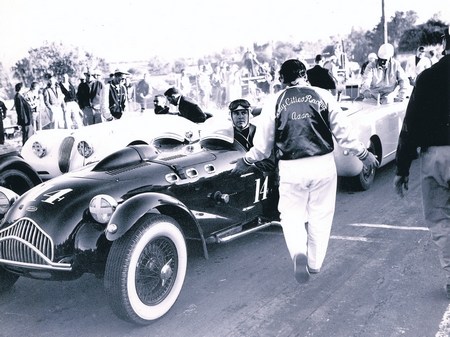The Pole Position
/
By Bill Pollack
Every time the number fourteen Allard raced it always started on the pole as the fastest qualifier. I don't think I really appreciated just how important that really was until years later. Thinking about it I'm not sure how I really accomplished that. It didn't seem to matter where we raced, the car was just scary fast compared to other cars in the field.
Being on the poll was always a little frightening because you have the entire field behind you, thousands and thousands of horsepower all screaming to go and if for some reason I stalled or some other stupid thing, it would be a terrible mess.
I know that when I was in front and the starter would give us the signal to start your engines there was always that awful moment when you thought God I hope the battery isn't dead. After the engine roared to life I've probably put the car in 1st gear at least 5 or 6 times just to make sure I was really in 1st gear. Sometimes I would actually let the clutch out just a little bit to make doubly sure that I was in number 1 slot. Of course, that was only the beginning.
My adrenal glands had probably been asleep for weeks or months since my last race and it was a rude awakening when the clutch came out and the car burst forward in a blinding explosion of speed. For some reason my vision immediately narrowed down to the front wheels and the road directly in front of me with little or no indication of what might be in my periphery. I don't think I was really aware of who was chasing me until at least the 2nd or 3rd corner had been negotiated without any serious mishap. Finally, I probably took a deep breath or let one out that I had been holding since the start of the race, and took a look to see who was back there. It was no surprise when it was usually Phil Hill.
I've never really had a chance to talk to other drivers about what it's like to sit in front and lead a race from pole to pole or from start to finish. The pressure which is enormous at the beginning of the race gradually diminishes as you complete each lap without serious actions bordering on dumb. There were moments when only you and no one else realizes that you had probably made a very small error and you simply told yourself don't even think about doing that again. It might have been experimenting with a slightly different line on a corner or changing the breakpoint for slow down by 5 or 10 feet. You quickly learn that the once you're in front this is not a good time or a place to experiment with how to go faster. After all, you're in front, what more do you want, all you have to do is stay there and everything should work out to your satisfaction.
People often commented to me about how difficult it must have been to drive the Allard, which they assumed was a bad handling car. The people who made those comments had never driven that car so I always took them with a grain of salt. But it wasn't until I drove several other Allards and then the black number 14 that I realize how much minute care and preparation went into that particular car. It was a number of adjustments and modifications that were made that resulted in the handling characteristics of that car being far superior to any other Allard I ever drove. Tom Carstens, in fact, had won a championship in midgets so he was well equipped to set up a car. Tom Carstens and Dave Fogg, his partner, were a team that was hard if not impossible to beat.
These days for a couple of hundred thousand dollars you can buy something from Italy, Germany or Great Britain that will go fast and is fun, but I will put up the Allard up against them. The Allard in terms of fun would be at the top.

